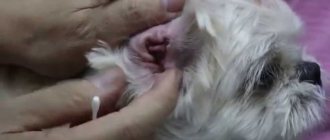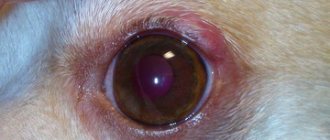Coronavirus, or coronavirus enteritis (CCoV) is a dangerous infectious disease that causes hemorrhagic inflammation of the intestines, exhaustion and dehydration. Today it is one of the most common contagious diseases in the world, in which the mortality rate of puppies up to 6 months of age can reach 50%.
Canine coronavirus enteritis is not dangerous for humans
Enteritis in dogs: types, symptoms, treatment and prevention measures
Viral enteritis is one of the most common diseases in dogs. This group of infectious diseases is characterized by intestinal inflammation. But the disease develops quickly and affects the kidneys, liver, heart and other organs. Enteritis affects animals of any age, but it most often affects puppies between two and twelve weeks of age. Since severe symptoms and untimely treatment lead to the death of a pet, every owner should know the signs of this disease, methods of its treatment and preventive measures.
Types and signs of enteritis in dogs
Depending on the pathogen, enteritis is divided into coronovirus and parvovirus . In Russia, the infection was first registered in 1980. Having become infected with enteritis, animals that did not have immunity often died. Mostly puppies aged 2 to 10 months suffered from this disease. And although many methods have now been developed for the prevention and treatment of enteritis, this insidious disease has not yet been fully studied.
Coronavirus enteritis in dogs
This milder form of enteritis has an incubation period of up to 5 days, and can occur in both acute and mild forms.
The acute form develops quickly and has the following symptoms:
- minor abdominal pain;
- rare vomiting and diarrhea;
- the dog may refuse to eat, but maintain a drinking regime;
- the pet becomes lethargic and weak.
Quite often, a secondary infection joins the acute form. Mostly weakened puppies die with this form. Adult dogs are recovering well.
A mild form of coronavirus enteritis can be asymptomatic. In some cases, the pet may experience a lack of appetite and lethargy. The animal's temperature does not increase. After a few days the condition improves.
Parvovirus in dogs
Parvovirus infection is divided into three types:
The cardiac form of parvovirus occurs in very young puppies , which are not yet 9 weeks old. Its symptoms include:
- Refusal to eat.
- Lethargy.
- Drowsiness.
- A rumbling sound that can be heard from a distance.
- There is usually no diarrhea, and there is no severe abdominal pain on palpation.
- The heart muscle is affected, which leads to quiet and imperceptible breathing of the animal or, conversely, to severe shortness of breath.
- Mucous dogs become bluish and pale.
- All extremities are cold.
- The pet has a weak pulse.
The intestinal form of enteritis also mainly affects puppies. It manifests itself with the following symptoms:
- Refusal to eat.
- Lethargy.
- Fever, which may not occur in the first 2-3 days.
- First of all, repeated foamy and stringy vomit appears.
- Then watery, loose stools develop, characterized by a putrid odor. After a few days, blood appears in the feces.
- The dog develops severe pain in the abdomen, when touched, the pet begins to whine and tuck its tail.
The main problem with the development of the intestinal form of parvovirus is dehydration of the dog’s body, which can die within two to three days after the onset of the disease.
In the mixed form of parvovirus enteritis, the heart muscle and intestines are affected. Most often it develops in puppies that are born from unvaccinated bitches and in weakened dogs with rotovirus and adenovirus infections.
Causes of the disease
Any dog of any breed is at risk of contracting the virus, even if it has all its vaccinations and is kept in ideal conditions. But still there are certain points that require increased attention from the owner.
Risk group
The risk group primarily includes unvaccinated animals: their body’s resistance is significantly lower than that of vaccinated individuals. Vaccinated pets can also become infected, but it will be mild and will not be life-threatening.
Puppies and teenagers under one year of age are also often attacked by viruses: harmful microorganisms happily settle in fragile tissues. Dogs in kennels, shelters and other crowded places are especially susceptible to enteritis.
Conditions of detention
There are several different reasons why a pet is at risk of becoming a victim of the virus:
- Lack of regular comprehensive vaccinations
. Vaccinations are given to puppies at the age of 2 months, during the first visit to the veterinary clinic. Revaccination is needed after a few weeks, and then annually. - Poor nutrition
. The non-viral form of the pathology is often caused by poor-quality food, a sudden change in food, or food poisoning. The intestinal mucosa reacts poorly to foods that are too cold or hot. The presence of preservatives, seasonings, and an abundance of salt also causes problems. - Weakened immunity
. A strong immune system prevents dangerous microorganisms from multiplying inside the pet's body. Weak immunity, especially in young individuals, is favorable for the development of pathogens. - Worms
. Parasites that live inside the body cause many problems: they undermine the immune system, cause dysfunction of the gastrointestinal tract, and provoke inflammatory processes on the mucous membranes.
It is important for the owner to avoid the listed factors so that his four-legged friend can maintain good health and avoid infection. A strong immune system, proper diet and timely vaccinations form a reliable barrier against any infections.
Treatment of enteritis in dogs at home
First of all, a puppy with symptoms of infection should be removed from other animals . However, such a quarantine does not guarantee that the remaining dogs did not become infected. In any case, the sick pet should be in another room.
Antibiotics and immune drugs
First of all, treatment should begin with the administration of drugs that will increase the dog’s immunity. For this purpose, immunofan and fosprenil are used in the form of injections.
Immunofan belongs to veterinary drugs that are aimed specifically at the treatment and prevention of enteritis. This immune drug helps the body cope with viral infections. It can be used both for a sick dog and as a prophylactic for a healthy pet. It can be administered intramuscularly or subcutaneously 2-3 times a day, 1 ml .
Fosprenil is intended for the treatment of various viral diseases in animals. Used for the treatment and prevention of enteritis. The dose of the drug administered intramuscularly or subcutaneously is 1 ml per kilogram of puppy weight. A sick dog is treated with fosprenil for 3-5 days. They stop giving injections only when it is clear that the pet has begun to recover. For healthy puppies, 2-3 injections are enough for prevention.
Immunofan and fosprenil have no contraindications, so even if the puppy is not sick, they will not cause harm.
If the dog has not been vaccinated, then along with the drugs described above, hixane or globcan serum is added . These immune drugs are intended for the treatment and prevention of enteritis. They dramatically increase immunity, but act only for 10-14 days. If the puppy is healthy at the time of administration of the serum, then thanks to the drug he will not get sick. If the dog has already become infected, then during the incubation period the serum will alleviate the disease.
The disadvantage of hixane and globcan is that they neutralize the effect of vaccinations. Therefore, if the dog was previously vaccinated, after the administration of the serum it will need to be vaccinated again. In this regard, it is recommended to administer these drugs only when you are absolutely sure that the puppy has enteritis.
Treatment of a sick pet with serum depends on the condition of the dog. The drugs are administered at intervals of 12-24 hours, one dose 1-3 times a day. For prevention, the serum is administered once.
Having treated the dog with antiviral and immune drugs, nothing else is done until the first symptoms of the disease appear. Quite often, the pet’s stool changes soon. It becomes watery, bloody brown, with pink mucus and a “rotten” smell. Antibiotics are needed to treat it.
Symptoms and diagnosis
The initial symptoms of enteritis in dogs, regardless of the type, are the same:
- lethargy, apathy, no reaction to favorite toys or owners;
- refusal to eat , even the most previously desired delicacies;
- increase in temperature in the first hours after illness;
- vomiting 10 hours after refusing to feed and drink;
- diarrhea with blood.
Veterinarians, depending on the type of virus that caused the disease, divide it into two forms: parvovirus and coronovirus.
Parvovirus form
It is this form of the disease that is considered the most rapid in development, and it is the one that affects puppies. Why? Because the most favorable environment for parvovirus is an abundance of dividing cells, i.e. baby's growth. Therefore, every dog breeder should know the symptoms and treatment of parvovirus enteritis in dogs.
This disease affects not only the animal’s intestines, but also the heart. Or it can hit both. Therefore, parvovirus is divided into cardiac, intestinal and mixed. Therefore, the symptoms of parvovirus enteritis in dogs will vary.
1. Symptoms for the intestinal form:
- instant development - here the dog is playful, but now it is lying down and does not react to anything;
- profuse, constant vomiting (foamy masses, color yellow);
- severe diarrhea for 1-3 days (the stool is watery or mucous, the color is red, yellow, brown, green or completely black), the smell is heavy;
- in addition to loss of appetite, a refusal of water appears when the animal does not take fluids for 1-3 days - a characteristic sign of parvovirus enteritis;
- paw tremor, weakness, staggering;
- dehydration that occurs within 10-12 hours;
- a sharp increase, and then (over 1-2 days) a decrease in temperature to normal.
If the temperature drops below normal, this is a bad sign: there is a high risk of death (about 80%).
2. Symptoms of the cardiac form:
- dry cough;
- complete refusal of food and drink (puppies are not able to suck the bitch’s milk);
- sudden, severe weakness, increased heart rate, shortness of breath;
- mucous membranes change color to bluish;
- development of pulmonary failure and myocarditis;
- The dog no longer gets up, he just lies down.
3. Symptoms and treatment of enteritis in dogs with a mixed form are diverse: they combine signs of both intestinal and cardiac enteritis.
In the event that sneezing, runny nose, and pus in the eyes are added to the symptoms listed above, this is another viral disease.
Coronavirus enteritis
This form is easier than the previous one: the symptoms are similar, but not as severe. Coronavirus enteritis in dogs is less contagious because it is transmitted only through the feces of a sick animal. And vaccination against it is more effective, and if the vaccinated dog gets sick, the disease may go away completely unnoticed by the owners. This form of the disease can be acute and hidden.
1. Symptoms in the acute form are as follows:
- apathy, lethargy, lack of response to toys or owners, lying down;
- loss of appetite and refusal to feed, however, the dog will drink;
- slight fluctuations in temperature are possible, but more often it remains within normal limits;
- vomiting only a few times a day, and not at all as profuse as with parvovirus;
- diarrhea that is yellow, not bloody, but long enough to cause dehydration;
- The pulse is normal, the breathing rhythm is normal;
- mucous membranes become pale.
2. Symptoms for the latent form are:
- for a long time the animal remains in a depressed state, in apathy;
- chronic diarrhea develops, appetite becomes weak or disappears altogether;
- The pulse drops and the body becomes exhausted.
Dogs affected by the latent form act as carriers of the disease. They do not develop severe symptoms.
Possible complications
Even timely treatment and mild enteritis are not a guarantee that the infection will end without complications. Quite often, after an illness, dogs are left with the following consequences:
- Puppies exposed to the disease before 9 weeks of age may develop myocarditis, which is a heart disease. In some cases, adult dogs also suffer from it.
- Bitches can become infertile for life or for a few months.
- After 2-3 weeks, polyps may be detected in the pet’s oral cavity, which are surgically removed.
- Puppies that have been ill grow poorly and are delayed in development.
- The dog may develop lameness that disappears after a few months or remains for life.
With full treatment and a mild form of the disease, complications usually disappear within a year .
Prevention of enteritis
The only way to prevent your dog from contracting the virus is with a vaccine. Currently, to prevent infectious diseases, puppies are vaccinated at the age of two to three months. Adult dogs should be vaccinated annually. To save your pet's life, be sure to vaccinate it against enteritis .
Since enteritis is a very serious disease and can even lead to the death of a dog, your pet should be shown to a veterinarian at the first symptoms. Only a timely diagnosis, timely assistance and proper treatment will help save the life of your pet.
Treatment of enteritis
Treatment of acute enteritis
Treatment of acute enteritis in children and adults is carried out in a hospital. The acute toxic form of the disease is treated in the gastroenterology department, infectious enteritis - in the infectious disease ward. Treatment of viral, coronavirus enteritis and other forms of the disease is carried out based on test results and individual characteristics of the body. Patients are prescribed a diet with a limited content of fats and carbohydrates, drinking plenty of fluids, taking hydration therapy measures if necessary, bed rest, restorative and symptomatic treatment. With the development of a severe form of dysbiosis, drug correction of the intestinal flora is carried out, and diarrhea is treated with astringents. In case of protein metabolism disorders, polypeptide solutions are administered.
Acute enteritis is usually treated for about a week; after the acute symptoms of the disease have subsided, the patient is discharged from the hospital.
Treatment of chronic enteritis
In case of exacerbations of chronic enteritis, treatment is carried out in a hospital setting. Absorption is stimulated by long-acting nitrate-containing drugs - nitrong, sustak, etc. The functionality of cell membranes in the intestinal epithelium is restored by protective agents - essentiale, karsil, etc.
Imodium is prescribed to suppress excess intestinal motility. If severe diarrhea occurs, antiseptics, astringents, adsorbents and enveloping drugs are prescribed. For these purposes, decoctions of chamomile, St. John's wort, sage, blueberries, bird cherry and alder cones can be used. Dysbacteriosis is corrected with the help of eubiotics and probiotics. Severe absorption disorders, accompanied by severe protein deficiency, are treated with intravenous infusion of amino acid solutions. When signs of enteritis appear against the background of various neoplasms of the small intestine (diverticula, polyps, etc.), they are surgically removed.
What is coronavirus infection: how does the disease progress in adult dogs and puppies?
Coronavirus is an infectious pathology that occurs in dogs in intestinal and respiratory forms. In adult animals it is characterized by a latent (hidden) course; it is more severely tolerated by puppies under the age of one year. Treatment is aimed at alleviating symptoms: eliminating diarrhea, vomiting, sneezing and coughing. There are no special drugs for viral infection.
Characteristics of the disease
Canine coronavirus (CCV, Canine Coronavirus) is somewhat related to feline coronavirus and can become a source of infection for the feline family. When a coronavirus infection is detected in dogs, it is advisable to isolate the sick individual from other pets in a separate room.
Coronavirus infection (Coronaviruses) is ubiquitous; antibodies to the disease are found in 55-60% of dogs at home. When examining animals kept in enclosures, coronavirus is diagnosed in 100% of cases in dogs of all ages and breeds.
The virus is transmitted through the fecal-oral route (feces, nasal mucus, cough). Sources of infection are sick animals with obvious clinical signs and virus carriers with a latent course of the disease.
Experts doubt the role of coronavirus as the primary pathogen capable of causing the disease, although it is isolated from sick animals. Coronavirus enteritis in a puppy is often positioned as a secondary pathogen.
The virus penetrates the structure of the cells of the mucous membrane of the thick and thin sections of the gastrointestinal tract, partially affecting nearby lymph nodes, but this does not have much significance in the disease.
The incubation period is from 1 to 7 days. After introduction into the body, the virus begins to actively release into the external environment after 14-16 days; on the 5th day of infection, antibodies that kill the virus are detected in the blood.
How does infection occur?
The intestinal form of coronavirus is most often diagnosed. The disease in a dog can begin with:
- Direct contact with a sick animal.
- Sniffing or licking waste products.
- Water and food contaminated with feces or mucus in the enclosure.
The virus is capable of maintaining its pathogenic properties in the external environment for a long time. Therefore, when identifying sick animals, it is necessary to thoroughly wash all premises with disinfectants and treat the pets’ personal belongings (bowls, rugs, etc.).
Infection with the respiratory form occurs through airborne droplets, sneezing and contact with mucus from the nose. Therefore, in kennels or in places where dogs gather, there is a rapid spread of the disease. The virus infects the epithelium of the upper respiratory tract with subsequent penetration into the small intestine.
The virus is able to penetrate cell membranes, actively multiplying and causing a significant blow to blood vessels.
Swelling of the mucous membranes of the gastrointestinal tract develops, the vessels become overfilled with blood, and digestion worsens. During the examination, foci of dead cells and ulcers are revealed; when bacteria are attached, suppuration or signs of other diseases may appear.
Symptoms of enteritis
Symptoms of acute enteritis:
- Acute enteritis usually begins with abdominal pain, diarrhea, nausea and vomiting.
- Headaches and fever are possible.
- Stool – up to 12-15 times a day, copious and watery.
- The patient has general weakness, pallor and dry skin, and a white coating on the tongue.
- The abdomen is distended and there is rumbling in the intestines.
- With prolonged diarrhea, a clinical picture of dehydration may develop, including muscle cramps and intravascular disseminated coagulation syndrome.
- Symptoms of hemorrhagic diathesis may also be observed - a tendency to thrombus formation and increased bleeding.
Symptoms of chronic enteritis:
Chronic enteritis is characterized by enteral and extraintestinal manifestations.
- Symptoms of enteritis also include: diarrhea, flatulence, cramping pain in the upper abdomen and around the navel, gurgling in the abdomen and rumbling. In the afternoon, when the organs of the digestive system are most active, more pronounced symptoms are observed.
- The patient experiences loose or pasty stools (up to 5 times a day), containing undigested food debris. Defecation is often accompanied by a state of weakness, possibly a drop in blood pressure, dizziness, tachycardia and tremors of the limbs - until collapse develops.
- There may be a painful urge to defecate, accompanied by seething and cramping in the abdomen, with greenish discharge of watery, scanty stool. With enteritis, the tongue is covered with a thick white coating, with teeth marks along the edges, the abdomen is swollen, and splashing and noises are heard on palpation of the cecum (Obraztsov’s symptom).
- With extraintestinal manifestations of chronic enteritis, malabsorption syndrome is observed - impaired absorption of nutrients in the small intestine. The lack of substances entering the body leads to hypovitaminosis, protein starvation and deficiency of mineral components - iron deficiency anemia, osteoporosis due to lack of calcium, etc.
- There is a decrease in body weight, and dystrophy progresses.
Respiratory tract pathologies
RCoV (a form of the virus that affects the respiratory tract) was identified in 2003. The disease is not considered dangerous; it is similar to the symptoms of ARVI. In fact, RCoV is part of a complex of viral and bacterial infections that can be combined into one group, “kennel cough in dogs.” The respiratory form of coronavirus is rarely diagnosed as a single disease and is detected in conjunction with adenovirus, streptococcosis, herpes, mycoplasmosis, parainfluenza, and bordetellosis.
The infection is transmitted by airborne droplets; a high risk of infection of adult animals and puppies is observed in nurseries, cramped spaces, in a pack of stray dogs, shelters or after visiting exhibitions. If a coughing or sneezing animal with characteristic nasal discharge is detected, it is isolated and the room is thoroughly disinfected.
People caring for dogs can become a source of infection with respiratory coronavirus. The virus is found on clothes, shoes, and hands.
Coronavirus in puppies and adult dogs in respiratory form has the following symptoms:
The temperature rarely rises and occurs more often with the development of pneumonia. In a dog with a strong immune system, it is almost impossible to notice that he is sick. However, the coronavirus is actively released into the external environment, infecting surrounding animals.
The timing of the latent period of the respiratory form of coronavirus has not been determined. According to observations, it takes 2-3 days for the actual development of the pathogen in the dog’s body. In mild cases of the disease, symptoms disappear after 1-2 weeks.
Therapeutic measures have not been developed, there are no drugs against the virus. Prescribe medications that eliminate cough, runny nose, and increase immunity.
Antibiotics are prescribed when a secondary bacterial infection occurs, when other pathogenic microorganisms begin to affect the weakened animal’s body. A sick animal must be isolated for a period of at least 3 weeks, and the house and all household items are disinfected. The dog owner should be especially careful when interacting with other pets; the infection can spread on clothes and hands.
Treatment of canine coronavirus enteritis
Puppies infected with this disease exhibit the most severe course of the disease with corresponding symptoms, which is why this age group requires the most attention. Veterinarians know that such simple manifestations of coronavirus as diarrhea and vomiting can lead to the death of a young dog in 2-3 days.
Adults can usually recover from this infection on their own without the use of drugs. However, this is only possible after diagnostics are carried out, which will make it possible to reliably find out that, apart from coronavirus, the dog does not have any other infections.
Sometimes diarrhea lasts 12 days, followed by soft stools for several weeks. If the infection has led to inflammation of the small intestine (enteritis), blood poisoning (sepsis) and respiratory problems, which sometimes occurs with a secondary bacterial infection, antibiotics will be required for treatment.
Intestinal form of pathology
Coronavirus enteritis in dogs (puppies and adults) multiplies in the mucous epithelium of the gastrointestinal tract, mainly in the upper 23 small intestines and adjacent lymph nodes. Coronavirus gastroenteritis in dogs occurs in a mild form with periodic manifestations of diarrhea and vomiting or does not manifest itself at all. This is a characteristic distinguishing sign of the disease from parvovirus infection in dogs. In some cases, parvovirus and other intestinal infections are added to CCV - then we are no longer talking only about coronavirus. The mortality rate of dogs from it is small.
Symptoms of infectious (viral) enteritis are variable and do not appear identically in different dogs. Most of the signs are hidden, there are no obvious physical ailments, sometimes there are single bouts of vomiting or explosive diarrhea with watery, yellow-green or orange-tinged feces.
Characteristics of coronavirus:
- Complete refusal to eat, even your favorite treats.
- Urge to vomit.
- Indifference to everything around you.
- There is rarely a fever.
- Weight is lost due to lack of food and loss of fluid from the body.
With weakened immunity (mainly puppies 6-12 weeks old), coronavirus is accompanied by prolonged diarrhea and severe dehydration. It is this aspect that becomes dangerous for puppies. In case of severe inflammation of the small intestine and not contacting a veterinarian quickly enough, death can occur.
Is enteritis dangerous for others?
Viruses that cause inflammatory bowel disease spread very quickly and easily into the environment. How dangerous are they and for whom?
Can humans and other animals become infected?
Surely you have had a rotavirus infection at least once in your life. And if you have a cat, you know it could have coronavirus or parvovirus. Does this mean that the dog is dangerous to others?
All of these viruses have subspecies, and canine rotavirus does not threaten humans, just as canine coronavirus does not affect cats at all.
Canine parvovirus can rarely be transmitted to cats, but this has been largely unnoticed in recent years.
Can a dog that has been ill or vaccinated get infected?
Unfortunately, re-infection is possible, but it will be milder. It is much easier to cure, and the dog’s life will not be in danger.
A vaccinated dog, once infected, will also easily get sick from any of the enteritis forms - all thanks to the fact that he already has immunity against the virus.
Enteritis in dogs is a very serious disease that leads to complications or death of the animal. It is quite difficult to cure due to a large number of disorders: vomiting, diarrhea, lethargy, lack of appetite, inflammatory processes in the gastrointestinal tract, disturbances in the functioning of the heart. Preventive vaccinations and other precautions will help protect your pet from this terrible disease.
The article is for informational purposes only. Contact your veterinarian!
How is the examination carried out?
If you suspect a coronavirus infection, it is important to take your pet to a veterinary clinic as soon as possible! A significant disadvantage of the disease is its similarity to many dangerous intestinal infections, in particular, parvovirus enteritis in dogs (a virus from the Parvoviridae family), and canine distemper.
It is possible to determine which virus provoked the disease using PCR, ELISA, and ICA. Rapid tests are highly accurate and the diagnosis is easy to make in 95% of cases. If a veterinarian prescribes such an examination, you cannot refuse.
An accurate diagnosis is made after examining feces under an electron microscope.
Description of the disease, causes
What is enteritis in dogs? Before the Olympic Games were held in the capital of Brazil, this disease was practically unknown in our country, and then an epidemic occurred. The virus became famous and spread further.
There are two causative agents of viral enteritis in dogs: parvovirus and coronovirus. Of these, the first is the most dangerous - it acts faster.
Most often, the disease affects puppies under 2 months of age, especially if they were born to unvaccinated dogs. In such a case, the mortality rate becomes very high.
The enteritis virus is so tenacious that even careful disinfection measures will not destroy it from furniture, wallpaper, or the ground, where the pathogen can survive for up to 1.5 years.
The virus is transmitted through the secretions of a sick dog: saliva, vomit, urine or feces.
For infection, minimal contact is enough - for example, for a dog to sniff a patch of ground where an ailing animal has urinated. This is one of the most dangerous diseases among those that threaten the health of furry pets.
The incubation period of the virus is one week on average. In puppies, especially unvaccinated ones, this period is reduced to a maximum of two days.
Basics of therapy: what to do
Treatment of the animal must begin as early as possible, especially for puppies under 4 months.
They are placed in a hospital or ICU (intensive care unit) under round-the-clock supervision. Vomiting and diarrhea cause severe loss of water in the body, water balance is maintained with the help of infusion therapy (drip).
Treatment will help the animal recover faster and overcome the effect of coronavirus on the body.
Purpose for respiratory form:
- expectorants (thin the mucus, the dog coughs it up);
- hormonal agents;
- vitamins;
- hyperimmune serums (with a large amount of antibodies to fight the disease);
- saline solutions (or saline solution).
Dry crusts on the nose are removed with a soft swab dipped in a disinfecting solution, the air in the room is humidified, and the possibility of a secondary bacterial infection is excluded. Broad-spectrum antibiotics are sometimes indicated.
Prescriptions for intestinal form:
- gastrointestinal protective agents;
- anti-vomiting medications;
- analgesics (relieving pain) and antispasmodics (relieving spasms);
- decongestants (helping the gastrointestinal mucosa return to normal);
- antibiotics (according to indications).
If there is a large loss of fluid from the body, intravenous or subcutaneous infusions of glucose, electrolytes, amino acids, etc. must be used. If the dog does not eat for more than 3 days, parenteral nutrition is prescribed (intravenous, bypassing the gastrointestinal tract).
There is no drug that can cure coronavirus infection. Vaccination is not advisable due to the lack of a vaccine as such and the low risk of death. CCV is not considered a serious disease; Multikan-6, Multikan-4 and Duramune MAX 5 L4 CV are sometimes used. The vaccine against the intestinal form is not effective against respiratory manifestations of the disease.
Canine coronavirus is not dangerous for humans, but the owner himself can become a source of virus infection for other animals (pigs, cats, dogs). The disease can be prevented by following basic rules of pet care and hygiene, especially in crowded conditions. It is recommended that puppies and weakened animals be walked outside dog walking areas and not allowed to sniff marks, waste products, or get to know other pets.
Coronavirus in dogs: causes, symptoms, treatment
For several decades now, humanity has been continuously fighting viral diseases. These diseases affect not only people, but also animals. To this day, no specific cure for viruses has been found; all hope for getting rid of viral infections rests only on the immune system of the sick person.
Coronavirus infection is common among dogs, affecting pets of absolutely any breed and age group. For adult pets, the disease is not considered fatal, but for young animals, infection with coronavirus can end tragically.
What is coronavirus
At the end of the 20th century in Germany, virologist scientists discovered a new type of infection called coronavirus. It was found that it was this pathogen that caused enteritis in guard dogs. At the beginning of the 21st century, the attention of scientists was attracted by the fact that a group of dogs kept in the same enclosure became en masse sick with the same disease (the animals developed a cough).
Virologists carefully began to study a form of infection previously unknown to veterinarians and discovered that this condition of animals is caused by the penetration of the same virus into their body.
The virus has low resistance to environmental conditions: in a heated room the pathogen dies after a few days and is resistant to boiling and most disinfectant solutions.
Today, coronavirus is divided into 2 types of infection:
- Intestinal.
- Respiratory.
Neither type of coronavirus is considered a fatal disease for adult dogs, but if secondary inflammatory processes are added to this infection, this condition threatens the pet’s life. Coronavirus is extremely dangerous for young dogs and puppies, as this disease is often complicated by parvovirus enteritis, which causes high mortality among young animals.
Be sure to read our article on parvovirus infection in dogs
How does coronavirus infection occur?
The incubation period of the disease lasts up to 10 days, and often, even the most attentive owner is unable to suspect that the pet is already infected with the virus.
The first type of coronavirus is transmitted from a sick dog to a healthy one in the following ways:
- in direct contact with animals (for example, sniffing);
- through the excrement of an infected dog (a healthy animal can eat the feces of a sick dog, or get dirty in it, and then lick the fur);
- through contaminated water and dog food.
It has been established that there have been cases of coronavirus infection through contact with old feces, which means that under favorable environmental conditions the virus can remain active for several months.
The second form of coronavirus infection is transmitted exclusively by airborne droplets and is most often recorded in places where dogs are kept in large numbers (kennels).
Once in the dog's body, the virus destroys epithelial cells in the nasopharynx and then in the small intestine. Penetrating through cell membranes, the pathogen begins to actively multiply, striking the cells of blood vessels. As a result, the gastrointestinal mucosa swells, turns red and ceases to efficiently perform the function of digestion. Soon, foci of erosion and necrosis develop in the inflamed area of the mucous membrane, into which pathogens of secondary diseases can enter.
Diagnostics
The primary diagnosis is made on the basis of interviewing the patient and collecting anamnesis, as well as taking into account data from a general examination, percussion of the abdominal wall and palpation.
A coprogram is used as diagnostic laboratory methods; during macroscopic studies, consistency, color and smell are noted. Microscopic examination reveals the presence in the stool of a large amount of muscle fibers (creatorrhoea), fat (steatorrhea) and starch (amilorrhea). In most cases, the acid-base indicator changes.
In order to diagnose disorders of absorption functions in the small intestine, functional tests (absorption tests) are carried out: determination in saliva, urine and blood of carbohydrates and other substances taken before analysis (iodine-potassium test, test with D-xylose). Disruption of intestinal digestion processes at the molecular and cellular level is detected using the jejunoperfusion technique.
Symptoms of coronavirus in dogs
For each dog, the signs of coronavirus infection can vary significantly, since the severity of the disease is influenced by age, the state of the body’s protective function, as well as the presence of other concomitant diseases of the animal. In most cases, coronavirus occurs without any symptoms, but sometimes your dog will experience brief vomiting or diarrhea (with green or orange feces). An increase in body temperature is observed very rarely, but a sharp lack of appetite and severe weight loss of the animal are the most common symptoms of the intestinal form of coronavirus.
Pay attention to other viral diseases in dogs:
Common signs of coronavirus infection are considered to be:
- Lethargy, apathetic state of the dog;
- Severe dehydration, and as a result – significant weight loss;
- Frequent vomiting;
- Complete refusal of food;
- Diarrhea (feces have a watery consistency and a foul odor).
The respiratory form of coronavirus occurs like a common cold and is not considered a dangerous condition for the animal.
Symptoms for the respiratory form are as follows:
- Mucous discharge from the nasal cavity;
- Sneezing;
- Frequent cough;
- Increased body temperature (in very rare cases).
Sometimes, with the respiratory form of coronavirus, the development of pneumonia (pneumonia) is observed, but such a complication occurs in extremely rare cases and indicates the addition of other bacterial infections.
First aid for suspected illness
Since the infection develops rapidly, it is important to contact a veterinary clinic as soon as possible. If this is not possible, then the first consultation is carried out by telephone. Pathology cannot be ignored. Before going to the hospital, you can take the following steps:
- Constantly check your body temperature and record changes. This will help in the future to more fully present the picture of the malaise.
- It is important to monitor the type of excrement and vomit. The appearance of red or white feces is a dangerous sign indicating deterioration in health. The foul odor of the discharge should also alert you.
- It is necessary to ensure peace for the dog, place him in a room without drafts and unnecessary noise. The room must be constantly cleaned using disinfectant solutions.
- Feces and vomit must be constantly removed to prevent the spread of infection.
- It is important to give the animal warm boiled water. If the dog does not drink on its own, then the liquid is given through a syringe. This must be done so that the patient does not die from dehydration.
- You cannot force your pet to eat, because he simply cannot do this due to the inflammatory process in the intestines.
Without drug treatment, healing is almost impossible. The veterinarian should prescribe medications after examination, laboratory tests and conversation with the patient’s owner.
Diagnosis of the disease
At the first suspicious signs of disease, the animal should be shown to a veterinarian. Based on a clinical examination, a specialist can only make a preliminary diagnosis; accurate confirmation of coronavirus infection is carried out using laboratory diagnostic methods, namely:
- Serological analysis - determination of pathogen antibodies in the blood of a sick animal;
- Luminescent examination of feces for the presence of the virus (feces should only be fresh);
- Immunographic study.
Treatment of coronavirus infection
Unfortunately, there is no specific drug for the treatment of coronavirus; all therapy during the disease is aimed at strengthening the dog’s immunity and restoring its weakened body.
The treatment regimen for coronavirus infection is as follows:
- Administration of immunoglobulin serum.
- The use of vitamin complexes.
- Use of physiological solutions to relieve dehydration (administered only by drip).
- Prescription of antispasmodic drugs.
- The use of adsorbent substances to relieve intoxication.
- The use of antimicrobial drugs to prevent and eliminate secondary inflammatory processes.
A recovering animal definitely needs a diet. The food should be soft or liquid; you can feed the dog only in small portions. In addition, a recovered pet should not be subjected to physical activity for at least another month after recovery.
Treatment
The general treatment regimen for intestinal infections involves an integrated approach.
- A sick dog is isolated from other animals and given complete rest. It is recommended to disinfect the area and boil water for drinking. Prescribed:
- Antiviral (serums, immunoglobulins) - prevent the proliferation of viruses, promote cell restoration, stimulate the immune system (Giscan, Vitacan, Immunofan, Cycloferon, Fosprenil).
- Rehydration and detoxification - to restore water and salt balance (Ringer-Lock solution, Trisol, Hydrolysin, Hemodez, Enterosgel, Sirepar).
- Antiemetics (Serenia, Cerucal).
- Painkillers (No-Shpa).
- Hemostatic agents, in the presence of blood in vomit or feces (Vikasol, Etamzilat).
- To maintain cardiac activity (Sulphocamphocaine, Cordiamin, Riboxin).
- Antibacterial. To prevent and eliminate bacterial infection
- (Amoxicillin, Cefazolin).
- Probiotics. To normalize intestinal microflora (Bactoneotim, Bifitrilak).
The duration of treatment varies, but not less than 7 days. The doctor may prescribe additional medications and recommend gastric and intestinal lavage, which will help reduce the processes of rotting and fermentation.
Diet
It is important in treatment. In the first days, complete fasting is indicated. Only clean boiled water should be freely available. When the condition improves, they begin to introduce liquid food (low-fat broths with a small amount of rice or oatmeal). After a few days, if the dynamics are positive, the introduction of white meat, lean fish, and boiled eggs is allowed. Food is given in small portions in crushed form. Dairy and fermented milk products should not be given.
You should not self-medicate. Only a veterinarian can competently draw up a treatment regimen, determine dosages and optimal methods of administering drugs.
Complications
Coronavirus enteritis is also dangerous because it can lead to various complications:
- Heart failure, myocarditis;
- Temporary or permanent infertility;
- Slow growth and development in puppies
- Rupture of the wall of the small intestine, adhesions in the intestine;
- Peritonitis;
- Inflammation of the pancreas;
- Paralysis of limbs, lameness.
Vaccination is the best protection against coronavirus and other infectious diseases of dogs
Consequences of coronavirus
The disease itself does not pose a serious threat to the dog’s life, but very often, against the background of weak immunity, the animal develops more dangerous infections in parallel with the coronavirus. In most cases, parvovirus enteritis is recorded, which has a high mortality rate among weakened and emaciated dogs, as well as in puppies under 3 months of age. Very rarely, a respiratory coronavirus infection occurs along with an inflammatory process in the lungs, which also poses a danger to dogs in poor health.










